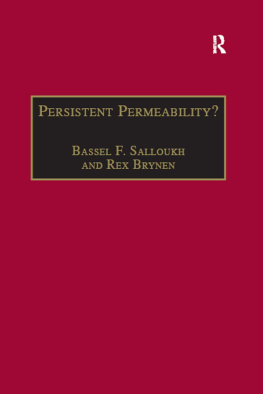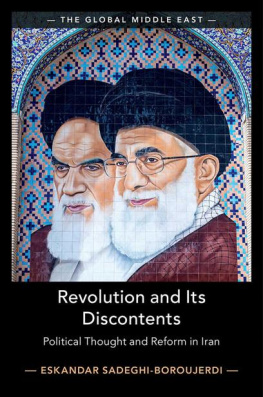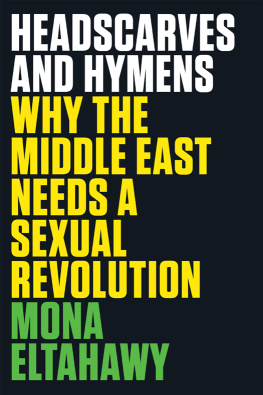Women and the Digitally-Mediated Revolution in the Middle East
This book applies digital methods of analysis to the study of the impact of digital technologies on the social and political spheres of women in Saudi Arabia and Egypt. These countries have been early embracers of digital technologies in the Middle East, and are therefore useful cases to examine the regions use of digital media. The author discusses what can be called the silent revolutions of these women online. By combining software studies, feminist Qurnic revisionism, actor network theory and digital methods research and analysis, the book explores how womens issues in Egypt and Saudi Arabia arise, transform and manifest themselves in the digital sphere, both in English and in Arabic.
C.L. Bernardi is Lecturer in Communication, Media and Culture in the Faculty of Arts and Humanities at the University of Stirling, UK.
Routledge Studies in New Media and Cyberculture
Between the Public and Private in Mobile Communication
Edited by Ana Serrano Tellera
Performing Digital Activism
New Aesthetics and Discourses of Resistance
Fidle A. Vlavo
Online Activism in Latin America
Edited by Hilda Chacn
Becoming-Social in a Networked Age
Neal Thomas
Free Software, the Internet, and Global Communities of Resistance
Sara Schoonmaker
Gay Men, Identity and Social Media
A Culture of Participatory Reluctance
Elija Cassidy
Digital Gambling
Theorizing Gamble-Play Media
Csar Albarrn-Torres
Digital Interfacing
Action and Perception through Technology
Daniel Black
Women and the Digitally-Mediated Revolution in the Middle East
Applying Digital Methods
C.L. Bernardi
For a complete list of titles in this series, please visit www.routledge.com
First published 2019
by Routledge
52 Vanderbilt Avenue, New York, NY 10017
and by Routledge
2 Park Square, Milton Park, Abingdon, Oxon OX14 4RN
Routledge is an imprint of the Taylor & Francis Group, an informa business
2019 Taylor & Francis
The right of C.L. Bernardi to be identified as author of this work has been asserted by her in accordance with sections 77 and 78 of the Copyright, Designs and Patents Act 1988.
All rights reserved. No part of this book may be reprinted or reproduced or utilised in any form or by any electronic, mechanical, or other means, now known or hereafter invented, including photocopying and recording, or in any information storage or retrieval system, without permission in writing from the publishers.
Trademark notice: Product or corporate names may be trademarks or registered trademarks, and are used only for identification and explanation without intent to infringe.
Library of Congress Cataloging-in-Publication Data
A catalog record for this book has been requested
ISBN: 978-1-138-31674-4 (hbk)
ISBN: 978-0-429-45548-3 (ebk)
Typeset in Sabon
by Apex CoVantage, LLC
1
Issues, Platforms and Methods
Background
This book is about womens issues in Egypt and Saudi Arabia, platforms and multiplicity. It will argue that womens issues have been enacted and enabled, manifested or silenced on many heterogeneous, but interconnected, platforms: social media platforms, UN-led or sponsored platforms of action, platforms of hope and platforms of solidarity, but also patriarchal platforms. Each platform has made the concept and umbrella term womens issues something new and different for each of the two countries discussed. Recognising that womens issues in these two major cultural and political players are multiple without being plural opens the doors to combinations and reflection on how data, computation and digital methods can intertwine with unrelated or apparently distant fields such as feminism or gender studies in a Middle Eastern context. These realms, or disciplines, as the book will show, can converge to propose innovative and much-needed reflections on gender, activism and digital networks. Various platforms will be discussed, each of them with its own sets of issues that have been enacted and actors that have played a role in this enactment. All these platforms culminate or simply evolve in what probably is the most complex, yet easiest to understand, platforms of all: social media platforms. As a consequence, the book will move between different fields and propose multiple methodologies to map what issues have been deemed womens issues in Egypt and Saudi Arabia, and how these have been enacted or transformed, silenced or amplified on a variety of platforms; it will then move to understand whether these issues are also present on social media platforms, or if, instead, new and natively digital womens issues emerge. Throughout the book I will make use of the reflections of Italo Calvinos Le citta Invisibili (The Invisible Cities) because his thoughts on data, connections and representation can best help understand the ethos of a multi-platform analysis of womens issues in Egypt and Saudi Arabia. The book Invisible Cities revolves around the dialogs between the trader and explorer Marco Polo and the Mongol Emperor Kublai Khan. While Marco Polo tries to focus on the ever-changing nature of things, the Khan is determined to map in a definite and finite manner his possessions. Some of the dialogues used in this iconic work by Calvino strive to reflect on the changing nature of cities, locations, people and reality as a whole. This is the case, for example, of the dialogue between Polo and Khan about the city of Melania, that appears to always remain the same. On the surface, in fact, both protagonists find it easy to map Melania. However, an attentive exploration of this apparent sameness of the city brings to light important details that highlight change. As Calvino writes:
[a]s time passes the roles, too, are not exactly the same as before; certainly, the action they carry forward through intrigues and surprises leads toward some final denouement, which continues to approach even when the plot seems to thicken more and more and the obstacles increase. If you look into the square in successive moments, you hear how from act to act the dialogue changes, even if the lives of Melanias inhabitants are too short to realize it.
(Calvino 1972, 37)
Introduction
The pervasiveness of technology underpinning much of current societal tasks has prompted new modes of analysis on the interplay of computation and cultural practices. Critical approaches and methods have engaged in reflections of media ecologies as dynamic interrelation[s] of processes and objects, beings and things, patterns and matter (Fuller 2005; Gottard and Parrika 2011).
Concurrently, feminist contributions such as Donna Haraways cyborg and Jodi Deans cyberia unfold questions of agency, multiplicity and gender in a technologically mediated world (Haraway 1991; Dean 2001; Haraway 2009). However, in spite of the richness of the interrogations on the new challenges posed by technology, as well as those that stem from increasingly hybrid identities, these reflections do not seem to have, as of yet, permeated the vast array of works on Middle Eastern gender and womens studies. Key terms such as digital media and big data have entered our everyday vocabulary, and this familiarity makes it necessary to understand what hides behind these two concepts with regards to their cultural and social relevance. The impact of the spread of mobile technologies in the Middle East, among many other geographies, came to the fore during the Arab Spring in 2011. Since then, the general public has been able to increasingly witness and follow different movements, revolts and revolutions. Most recently, smartphones and other handheld devices have documented, recorded, shared and commented upon the plight of hundreds of thousands in what has now been termed the European Migrant Crisis.Europe (Graham 2015). What this illustrates is that there needs to be an understanding of the digital in terms, and in light of, its intrinsic sociality and the relationality of certain events associated to it (McKenzie 2006, 23). This understanding is essential in order to make sense of the evolution of our increasingly computed and algorithmic culture.








